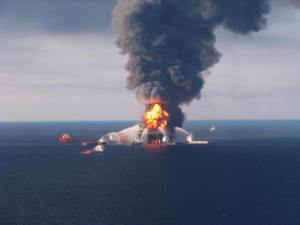Posted on December 10, 2012 by Bob Berwyn
An explosion and subsequent fire on BP’s Deepwater Horizon drilling platform in the Gulf of Mexico led to the biggest oil spill on recornd in U.S. coastal waters. Photo courtesy U.S. Coast Guard.
Study shows that sunlight intensifies the impacts of PAHs
By Summit Voice
FRISCO – In yet another sign that BP’s spilled Deepwater Horizon may have long-lasting impacts on Gulf ecosystems, a team of researchers said last week that even low-level, short-term exposure to traces of oil remnants causes deformities and impairs the swimming ability of fish.
The research was led by scientists with the University of Miami Rosenstiel School of Marine & Atmospheric Science. The school is a leader in the field of marine toxicology and used a state of the art hatchery to study the effect of polycyclic aromatic hydrocarbons (PAHs) on various species of fish, including cobia and mahi mahi.
PAH’s are toxic components of oil that are released from oil into the water column. The team also studied the effects of photo-enhanced toxicity, or the impact of sunlight on the potency of the toxic compounds found in the oil from the DWH spill.
A previous study by Smith University scientists showed similar impacts to fish during embryonic stages of development.
“We found that in more sensitive species the photo-enhanced toxicity could account for up to a 20-fold higher sensitivity,” said Dr. Martin Grosell, professor and associate dean of graduate studies for the Rosenstiel School. “This is an important part of the equation because it means that traditional toxicity testing performed under laboratory conditions will tend to underestimate the toxicity that might have occurred in the natural environment under the influence of sunlight,” he added.
The team collected freshly fertilized eggs from mahi mahi made available via UM’s Aquaculture Program, and exposed the embryos to low levels of different types of water mixed with DWH oil. In species like mahi mahi just 2 to 6 micrograms of total PAHs per liter of seawater were observed to reduce hatch rates and survival, and to result in impaired cardiac development.
The lab also tested newly hatched fish, observing them for deformities resulting from exposure to oiled seawater. Many hatchlings showed subtle heart abnormalities after only trace oil exposures in the egg that lasted only a day or so. After a month of raising these fish in clean water, the team put the resulting juveniles through the paces on their “fish treadmill” and they could only swim about 70 percent as fast as those that had never been exposed to oil.
“The severely reduced swimming performance we saw could impact the ability of these fish to catch sufficient prey, avoid predation, or travel the long distances that some migratory species require for survival,” Grosell said.
Other researchers included Andrew Esbaugh, Ed Mager, Charlotte Bodinier, as well as UM Professor and Aquaculture Program Director Dr. Daniel Benetti, Hatchery Manager Ron Hoenig and Graduate Student John Stieglitz, along with collaborators from NOAA’s Northwest Fisheries Science Center and the University of North Texas.
Special thanks to Richard Charter
